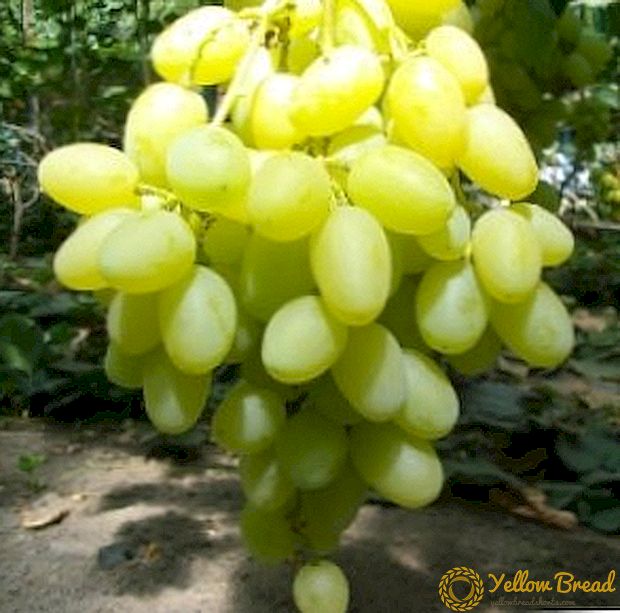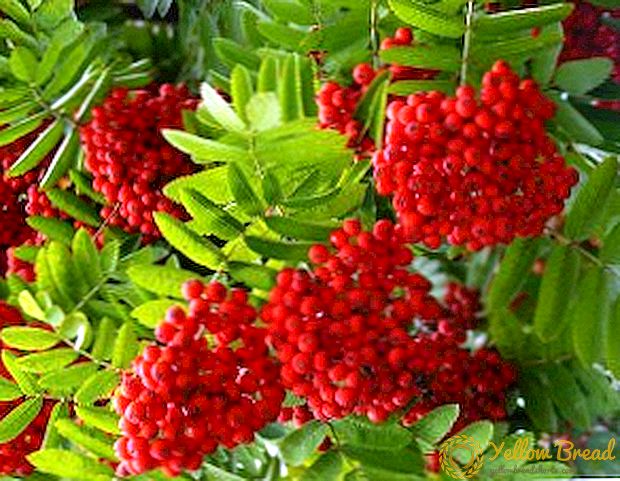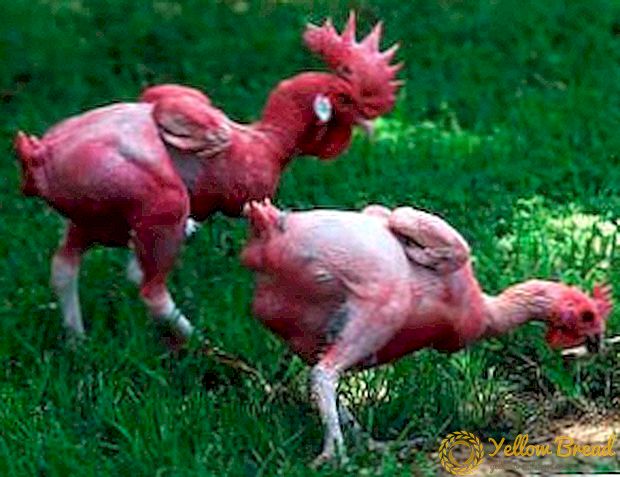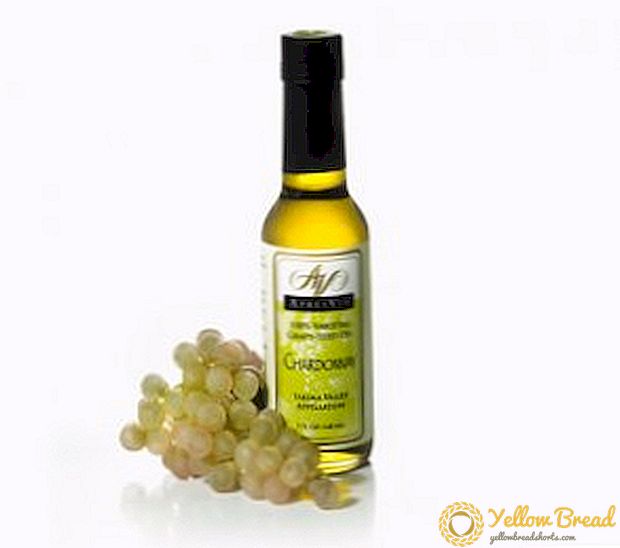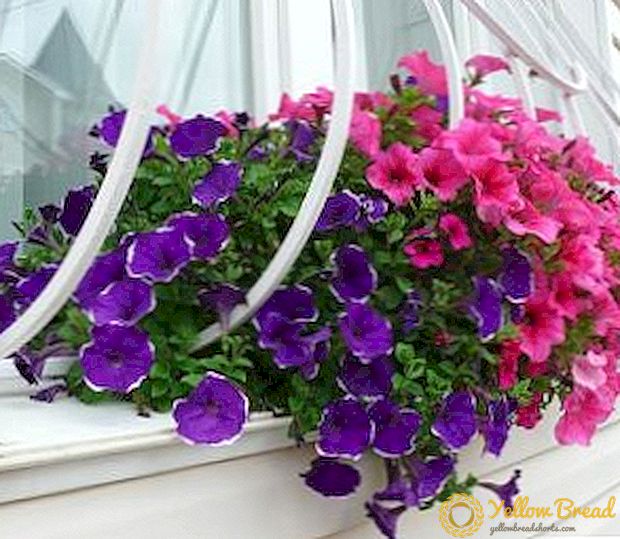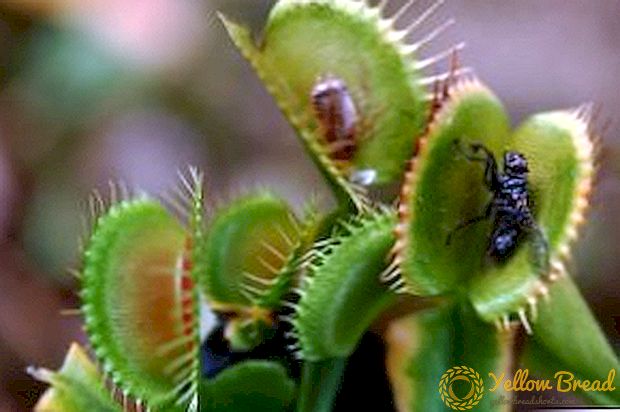 Many gardeners in search of early ripe tomatoes "Little Red Riding Hood" do not pay attention to the marvelous name "Rothkapphen", found on the bags of seeds. In fact, this is a German prototype of our favorite variety. What is the secret of its popularity, how does it differ from its domestic counterparts, and how to grow such tomatoes on your plot - this will be discussed further.
Many gardeners in search of early ripe tomatoes "Little Red Riding Hood" do not pay attention to the marvelous name "Rothkapphen", found on the bags of seeds. In fact, this is a German prototype of our favorite variety. What is the secret of its popularity, how does it differ from its domestic counterparts, and how to grow such tomatoes on your plot - this will be discussed further.
- Tomato "Little Red Riding Hood" ("Rotkeppchen"): breeding varieties
- Tomatoes "Little Red Riding Hood": characteristic
- Description of the bush
- Fruit Description
- Yield
- Disease and Pest Resistance
- Application
- Growing tomato seedlings "Little Red Riding Hood"
- Optimal timing
- Seed preparation
- Soil for growing seedlings
- Sowing seeds for seedlings
- Care and germination conditions
- Care for tomato seedlings
- Picking
- Location
- Watering
- Top dressing
- Hardening
- Planting tomato seedlings "Little Red Riding Hood" on a permanent place
- Optimal timing
- Selecting a landing site: lighting and soil
- The role of predecessors
- Optimal scheme
- Recommendations for the care of tomatoes "Little Red Riding Hood"
- Watering and weeding the soil
- Top dressing of bushes of tomatoes
- The role of mulch
- Masking and garter
Tomato "Little Red Riding Hood" ("Rotkeppchen"): breeding varieties
The authors of the "Little Red Riding Hood" tomatoes are German scientists from the Substitution Mauser Quedlinburg, who created a hybrid by pollination of several standard, disease-resistant, fruitful varieties of early ripening periods.
Local growers appreciated the innovation for its generous fruiting and high-quality harvest.
Over time, the popularity of tomatoes spread far beyond the borders of the country; therefore, in 1995, breeders were forced to do their zoning for cultivation in open soil and fresh consumption.
After the culture was adapted to the climatic conditions of temperate latitudes, it gained recognition from Ukrainian landowners.Some city dwellers manage to harvest even from the bushes planted in pots.
Tomatoes "Little Red Riding Hood": characteristic
The secret of the popularity of these tomatoes lies in the early ripening of large and tasty fruits, high stable yield, compactness of the bushes and their resistance to lodging. We will understand the features of tomatoes "Little Red Riding Hood" in the detailed description of the variety.
Description of the bush
The variety is a stunted standard bushes with a neat crown, not branched, with strong elastic trunks. On average, the maximum height of a crop reaches 40 cm, so there is no need to tie its stems to supports. The uniqueness of the breed is very simple care.
To get a good harvest a gardener does not need to pinch plants. In addition, tomatoes do not suffer with close planting. It is enough to create favorable conditions for them to grow in the open field or greenhouse. Miniature forms and power of stems contributes to resistance to lodging.
Fruit Description
From the moment of planting the seeds until the fruit ripens, it takes about 95-100 days. Tomatoes "Little Red Riding Hood" rounded slightly flattened form, slightly ribbed, with high-quality taste characteristics. They have a thin smooth skin, juicy fleshy flesh saturated purple color.
On average, the weight of one fruit varies between 65-70 g. In the hands, 5 tomatoes are usually collected. The peculiarity of the variety is that the fruits do not crack even under adverse weather conditions.
Yield
Regardless of external factors, the variety is characterized by consistently high fruiting. With one bush you can collect more than 2 kg of fruit, which is very good if you take into account the miniature plants. Agronomists of large agricultural enterprises do not hide the fact that up to 30 tons of crop are harvested from one hectare.
Agronomists of large agricultural enterprises do not hide the fact that up to 30 tons of crop are harvested from one hectare.
Disease and Pest Resistance
In addition to the other advantages of the "Little Red Riding Hood" tomato variety, breeders have instilled in him endurance genes for a number of diseases from which all nightshade suffer.Regardless of the area on which tomatoes are cultivated, with the right agricultural practices, vegetable growers will not have to constantly spray the bushes to avoid late blight, Alternaria and other pathogenic diseases.
Application
Due to their early appearance, the fruits of this variety are considered to be salad vegetables, so they are usually used for slicing vegetables, preparing fresh salads, as well as stews, vegetable dressings and soups. Of them, many housewives make juice and homemade ketchup, adjika, sauces.
Also, the tomatoes "Little Red Riding Hood" are suitable for canning green, as evidenced by reviews of fans of homemade spins. Unfortunately, this is not the case with ripe fruit. During heat treatments, they crack and look very unappetizing in the bank.
Growing tomato seedlings "Little Red Riding Hood"
"Rotkeppchen", like all varieties of tomatoes, grown from seedlings, which then rooted in a greenhouse or open ground. There are some subtleties of preparing the land and seeds for planting. Consider them in detail. 
Optimal timing
Given the early dates of ripening tomatoes "Little Red Riding Hood", the cultivation of their seedlings should be addressed in the last weeks of March. And if you plan to cultivate vegetables in a greenhouse, then sow grains preferably in late February. Then the stems quickly get stronger, and in April they can be transplanted into the prepared soil. Experienced housewives are advised to choose favorable days according to the recommendations of the Lunar Calendar.
Seed preparation
Last year's grains are not suitable for sowing, because they have poor germination. It is better to take material that is 2-3 years old. Before planting it should be soaked for several hours in a growth stimulator. For this purpose, suitable drugs: "Ecosil", "Acrobat MC", "Emistim".
Some gardeners share their experience in treating grains with a weak solution of potassium permanganate or a fresh aloe nipple. This is done to strengthen the protective functions of the plant. You can use the method of our grandmothers, who wound the seed in a wide bandage or gauze and dipped it in warm water for a day.
This is done to strengthen the protective functions of the plant. You can use the method of our grandmothers, who wound the seed in a wide bandage or gauze and dipped it in warm water for a day.
Soil for growing seedlings
For planting seedlings of tomatoes need a light mixture of equal parts of humus, garden and sod substrates. You can also add river sand and peat. All components are thoroughly mixed, poured into a prepared container and sent to a warm place to warm up. Do not forget to start preparing the ground in the fall, otherwise you will have to use the purchased material.
Sowing seeds for seedlings
Prepared seeds need to be deepened by 1.5 cm. To do this, water your mini-bed to keep it moist. Then palm it slightly tight. Spread the grains at a distance of 3 cm from each other and sprinkle them with soil. Lightly tamp the surface with your hand to remove any voids. Water and cover again with glass or another transparent lid. 
If there is nothing suitable, you can tie the box with a plastic bag. After the done manipulations, the “greenhouse” is put in a poorly lit, but warm place. The first shoots will appear in 4-5 days. Then move them to the windowsill. If the window is on the north side, you will additionally need a fluorescent lamp.
Many lovers of vegetable production prefer a more modern method, planting grains in peat tablets that can be found in any specialty store. They are pre-dipped in a plastic cup, watered until they swell, and only then the finger deepens the grain to the desired level.
From above, the container should be covered with a similar cup or tied with a plastic bag. This method is more simplified, since the grown stalks have enough space to build up a healthy root system.
Care and germination conditions
No matter what you germinate the seeds, they need to create favorable conditions for germination. Those in the first stages are light and heat. The temperature in the room where the seedlings sprout, should be at the level of 23-25 degrees Celsius.
And from the moment of the appearance of the first shoots, the temperature can be lowered to 16 degrees and you must take care of good lighting. After a week, the beds are kept at room temperature. Such changes contribute to the strengthening of plants and do not allow them to prematurely start to grow.
It is desirable to raise the box with the ground from the window sill to a small stand. This is done in order to avoid the influence of the cold window sill on the warm earth.
When the seed leaves develop, you can feed the seedlings. To do this, prepare a weakly concentrated solution with fertilizers "Uniflor-bud", "Kemeroy-lux" and pour.
Care for tomato seedlings
Competent care for grown seedlings of tomatoes includes several stages. Consider them in more detail.
Picking
So, our shoots successfully began to develop the first 2-4 leaves. If they grow in your box, they must be divided into separate pots. Before picking the earthen ball, water well so that the shoots are easily pulled out. To delay with this procedure is not worth it, because 20-day shoots can already be planted in a permanent place.In addition, a heavily overgrown root system will suffer greatly during transplantation. 
If you prefer peat tablets for planting, then the need for a pick-up disappears. Experts consider this method more comfortable, since it is not so troublesome, and the seedlings, without being injured, are very simply removed from the cups by pressing on their lower part or cutting one of the sides.
Location
In the future, the cultivation of seedlings should occur in a well-lit place where it is dry and warm. With a deficit of ultraviolet light, the shoots will be depleted and very fragile.
Ideal for pots of seedlings suitable southern window, where the sun will warm them for 12-14 hours. If this is not possible, you will have to compensate for the lack of light with additional lighting. In such cases, reflective screens are installed in front of the windows, which enhance the effect of the lamps.
It is also important to observe the temperature, because in the cold the shoots will stop developing or die altogether, and in the heat they will start to wither.The most optimal mark of the thermometer - at the level of 19-20 degrees.
Watering
Earthen clod in pots should not dry out and turn into a swampy slurry. Water the seedlings to the best of drying the top layer of the substrate, using only distilled water at room temperature.
Water the seedlings to the best of drying the top layer of the substrate, using only distilled water at room temperature.
Top dressing
2 weeks after the picking, the tomato stalks need additional nutrients. As a top-dressing use a solution of 1 tablespoon of nitrophoska and 1 l of water. Liquid enough for about 40 bushes.
Subsequent fertilization is also carried out after 14 weeks. Elongated and poorly developed sprouts will need superphosphate substances, stems with yellowed leaves - nitrogenous, and too pale - iron, received violet reflux on the veins - phosphorus.
Healthy stems are sufficient to be watered with “Effect”, although it is possible to add fertilizer in a foliar way.
Hardening
To facilitate future transplanting to more severe conditions, airing is arranged for grown seedlings. In sunny warm weather, open the window for a few hours during the day. Fresh air contributes to enhancing the protective functions and strengthening of tomatoes. It is important to avoid sudden drops, the minimum normal temperature limit is +8 degrees Celsius.
Planting tomato seedlings "Little Red Riding Hood" on a permanent place
Tomatoes "Little Red Riding Hood" for good yields require heat and moisture. Also important are competent dressings and selection of a place for planting. But about all this in order.
Also important are competent dressings and selection of a place for planting. But about all this in order.
Optimal timing
Transplantation of seedlings in open ground should be carried out when a stable daytime air temperature at a level of 22 degrees and above is fixed outside, and at night the thermometer will drop not lower than 17 degrees Celsius. In addition, spring frosts will be excluded.
Selecting a landing site: lighting and soil
The question of where it is better to plant tomato seedlings is relevant for those who are planning to organize a vegetable garden in the open field.The first thing you need to do when choosing to pay attention to predecessors, which we describe below.
Then from the remaining areas to choose the sunniest and warmest places where moisture and cold air flows will not accumulate. In such conditions, the risks of late blight and other diseases are very high. Pay attention that nothing cast a shadow on the tomatoes. They love a lot of heat and sun. 
The land for tomatoes must be fertile, soft and clean. During the maturation of the seedlings, weeds may appear in the designated area, so it is recommended to loosen and clean the bed before planting.
Regardless of the place of cultivation of vegetable culture substrate for it is important to fertilize. To do this, they mix equal parts of humus, peat, sod, rotted sawdust and a third of ash. On poor soils, superphosphate, potassium sulfate and urea will not be superfluous.On a bucket of a mixture prepared earlier, these components are added in proportions of 3: 1: 1.
The role of predecessors
If a tomato bed is broken up at the site where the nightshade was cultivated last year, the seedlings will suffer from the diseases and pests of their predecessors. In such cases, there is a high risk of lower yields due to the attacking Colorado beetles, the mischief of phytophthora, root and fruit rot, and the like.
In order not to expose the young culture to danger, you need to plan in advance the planting of all plants in the garden. It is better to plant the tomatoes after any kind of cabbage, beans, pumpkin, onion and garlic.
Optimal scheme
Sun-lover "Little Red Riding Hood" is planted according to the classical scheme with a distance between the rows of 50 cm and 40 cm between the bushes. But you can use another technology that provides for double rows and wide paths between them.
To do this, the tomatoes are planted on a half-meter strip in a checkerboard pattern with repeats after 80 cm.Many gardeners speak well of this method, noting that plants do not create a shadow for each other and receive enough light. In addition, the width of the paths allows you to stretch the hose for irrigation without damage to the bed [/ url or to make preventive treatment of the bushes.
Recommendations for the care of tomatoes "Little Red Riding Hood"
In the care of this variety is not much different from the other early maturing brethren. Experienced gardeners shared their secrets on how to accelerate the ripening of fruits and protect the bushes from prolonged resuscitation after diseases and attacks of pests.
Watering and weeding the soil
For the formation of the ovary and juiciness of the fruit, it is important that there is always enough moisture in the soil. But with watering should be careful, because the excess moisture will not benefit the plants. Therefore, the amount of water must be strictly controlled. For wetting, agronomists recommend making a shallow hole around each stem and pouring about 3 liters of water into it. In cases of the trenching method of planting seedlings, the moat is made between the rows.
The number of water treatments depends on weather conditions. Of course, in wet rainy weather they are not needed, and in the heat every evening you need to water the bushes for at least the first 14 days after transplanting.
Every wetting should be accompanied by loosening the soil. We must not allow a tight earth crust to form when the moisture evaporates near the trunk. It is also important to remove weeds in time, since they are a favorable environment for the development of pests, pathogens and fungal spores.
Top dressing of bushes of tomatoes
The opinion of the farmers on the amount of fertilizer of tomatoes divided. Some people think that the procedure should be repeated every 20 days, others are sure that 3-4 dressings are enough for the whole season. Agronomists believe that everything is right in its own way, because, in fact, the procedure is very individual and in most cases depends on the state of the plants and the soil in which they are cultivated.
At the beginning of the growing season it is important for the shoots to obtain a nitrogen rate for successful biomass growth. To do this, dissolve half a liter of infusion of liquid mullein or chicken manure in a bucket of water and add 1 tablespoon of nitrophoska.
In order for the fruit not to become a nitrate bomb, the bushes must receive phosphorus-potassium substances. Moreover, it is better to add wood ash to the mixture, not potassium chloride, because chlorine has a detrimental effect on the nightshade. Fertilizer is prepared from 0.5 liters of chicken manure infusion, 1 tablespoon of superphosphate and 1 teaspoon of potassium sulfate. Alternatively, you can use a mixture of 1 tablespoon of potassium humate and 1 tablespoon of nitrophoska.
Boron and magnesium are essential for all tomatoes during the budding period. Inflorescences will not crumble if they are sprayed twice with a solution of boric acid (1 g: 1 l).
The role of mulch
Poured and loosened bed with "Rotkapphenom" must be mulched in order to hold moisture in the ground. For this purpose, recommended buckwheat hulls, sawdust, straw and dry grass. But of all the options listed, experienced gardeners call hay the best mulch.
The fact is that this material has a beneficial effect on the physical characteristics of the substrate, contributes to its softening, looseness and nourishes during decomposition.For the experiment, some gardeners tried to close up one tomato garden bed with grass mulch, the other with sawdust, and the third with straw.
After harvesting the fruits, the looseness of the soil was measured with a metal pin. It was after hay that the rod went down by 40 cm without effort, when in the remaining areas it barely reached 15-25 cm.
Masking and garter
Due to the nature of the variety, "Little Red Riding Hood" does not need pinching the tops of the stems and tying to supports. The compact form of the bushes with favorable cultivation accompanies the rapid ripening of fruits without human intervention.
In fact, in the reviews of this German variety, there are no negative characteristics. Indeed, it is the most worthy selection of all early ripe tomatoes.

